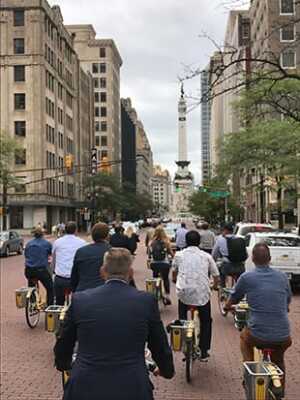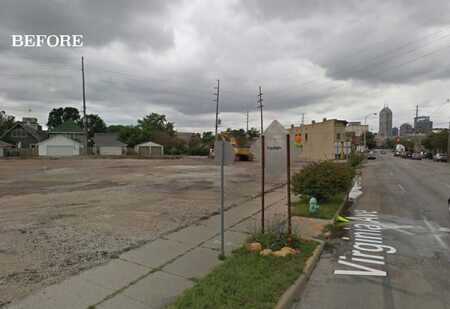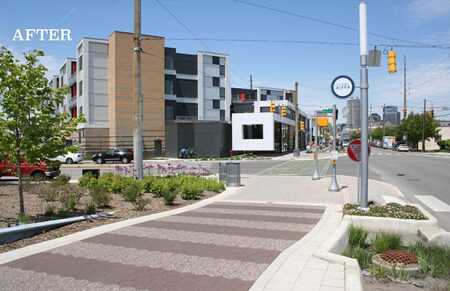Indianapolis has been leveraging active-transportation investments—primarily walking and biking—for both placemaking purposes and enhancing real estate values. Providing some inspirational examples for small-scale developers working in urban areas, the city’s story includes a collaborative spirit among the private, public, and philanthropic sectors; development enhanced by miles of trails; and soon, the construction of a bus rapid transit (BRT) system.
Drawing on those themes, the 13th Small-Scale Development Forum in September, “Small Meets Active Transportation,” included panel discussions and project tours in Indianapolis and its northern suburb of Carmel.
Jim Heid, founder of UrbanGreen® and CRAFT Development, Healdsburg, California, course coleader and founder of the forum, said that this year’s event continued the goal of creating “an inspiring learning environment for people passionate about real estate on a smaller scale.” Viewing small-scale developments as less about size than about the innovative, incremental spirit they embody, Heid said the intent is “to see markets that have benefited from this steady approach to revitalization.” Areas like Indianapolis provide a lower cost of entry alongside higher market stability, making them attractive to entrepreneurial developers.
Related: Jim Heid on How Small Developments Make a Big Impact
And the market has responded. According to Catherine Esselman, real estate development director at Downtown Indy, more than $10 billion has been invested in downtown Indianapolis projects since 2000. “We have both homegrown and out-of-town developers who like our market, demographics, and growth,” she said.
A Multimodal Mind-set
With its longstanding reputation as a convention city, Indianapolis has consistently focused on connectivity, from increasing flights to and from its frequently lauded airport to concerted efforts to make downtown walkable.
“As a community, Indianapolis has embraced multimodal transportation,” said Mark Fisher, chief policy officer with Indy Chamber.
In 2013, the city’s connectivity increased dramatically with the creation of the eight-mile (13 km) Indianapolis Cultural Trail: A Legacy of Gene & Marilyn Glick, later enhanced by the Pacers Bikeshare system. Indianapolis adopted a complete-streets ordinance in 2012 and has added more than 200 miles (322 km) of bike lanes since. BlueIndy, one of the nation’s most extensive all-electric vehicle-sharing systems, was introduced in 2015. And the connectivity will accelerate even more with the completion of the city’s new BRT system, currently under construction.
The Cultural Trail: Changing the Culture of a City While Driving Growth
The original intent of the Cultural Trail—envisioned by a cultural development commission as an urban version of the city’s Monon Trail, a rail trail completed in 2003—was to connect Indianapolis’s six cultural districts. According to Kären Haley, executive director of the Indianapolis Cultural Trail (the nonprofit organization that manages the trail), the goal was to create a sense of place and increase tourism by encouraging visitors to extend their trips to the city and to create a safe, beautiful, and accessible connection for residents.
The city of Indianapolis approved the use of right-of-way, the Eugene and Marilyn Glick Family Foundation committed $15 million as a lead gift, and in 2010, the city was awarded a $20.5 million Transportation Investment Generating Economic Recovery (TIGER) grant from the U.S. Department of Transportation for the completion of the Indianapolis Cultural Trail. Maintenance of the trail’s pavers, lighting, planters, public art, and snow removal is made possible by a maintenance endowment and ongoing fundraising efforts. The trail was completed in 2013.
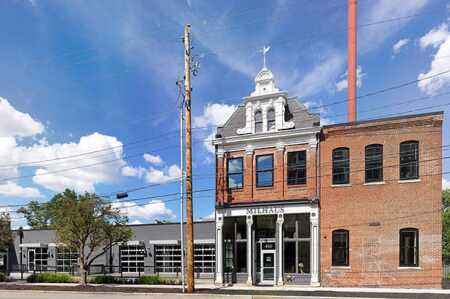
The bike tour included a stop at the Indianapolis offices of Milhaus, a mixed-use developer that specializes in class A, urban, multi-family residential buildings. Formerly the Shirley Engraving Co., the renovated, two-story building blends the historic structure with modern elements.(Courtesy of Milhaus)
“Over the past several years, the Cultural Trail has led the transformation of downtown Indy,” Haley said. “It’s putting us on the map as a place to go, live, work, and play.”
Today, a variety of developments can be found along the trail, and according to an Indiana University Public Policy Institute study, from 2007 to 2014, assessed property values for properties on or within 500 feet (152 m) of the Cultural Trail increased by 148 percent.
Craig Von Deylen, president and principal of Deylen Realty, is a design professional and a mixed-use developer who saw early on the promise of developing in emerging neighborhoods, as well as the value of the Cultural Trail. While serving on a greenways committee 10 to 15 years ago, he attended focus groups that explored the topic of where people wanted to live. When the conversations revealed walkability as the number-one driver, Von Deylen began thinking about other potentially walkable areas in Indianapolis, centering on the Fletcher Place neighborhood—an area that would eventually include the Cultural Trail—where he has since built multiple mixed-use properties. The combination of retail and amenity-rich residential buildings with the connectivity of the trail has been a winning combination for Von Deylen’s developments.
“The difference between success and failure in real estate development is about getting people there,” he said. “The multimodal concept is what’s driving small-scale development; we need to continue driving that process.”
When building on the trail, developers need to provide a protected area in the street for trail users, and they need to either protect or reconstruct the portion of Cultural Trail during construction. “We realize that’s a cost for you as a small-scale developer, but it results in people going by your project—value we think is worth it in the end,” said Haley. Von Deylen agreed. “To me, if you close the trail, you’re interfering with potential traffic in the future,” he said.
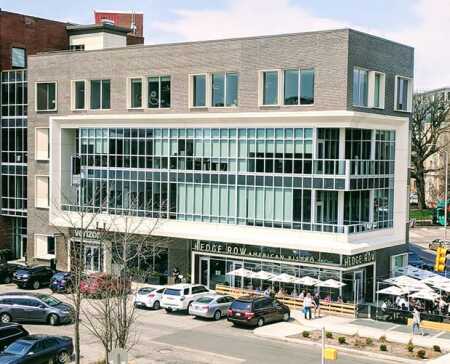
Attendees also visited The Marietta, which features three floors of upscale office space with natural light and a rooftop terrace. Its location offers connectivity to the Mass Ave Cultural District, Monument Circle and many other restaurant, retail and cultural attractions. (Dana Shirer, Gershman Partners)
Bus Rapid Transit: Connecting People with Jobs
“The Cultural Trail is an integral piece of how we’re creating value downtown, coupled with the significant investments of complete streets, and now, the BRT,” said Jeff Kingsbury, managing principal of Greenstreet and course coleader of the forum.
In 2016, 60 percent of Marion County voters supported a referendum to improve the city’s transit system through a 0.25 percent income tax. By introducing the BRT and creating three lines that function similarly to light rail, the project expands the existing transit network by 70 percent, extends service hours, and shortens wait times. The change comes at the right time for Indianapolis, where upward mobility and equitable growth are top-of-mind concerns for community leaders. By increasing connections between people and jobs, “expansion of the local network will be a transformative change for Indianapolis,” said Sean Northup, deputy director of the Indy Metropolitan Planning Organization.
Northup noted that successful transit-oriented development requires two elements: an existing market around the BRT stations and physical readiness—utility access, pedestrian connections, and short block lengths. “Transit is a market enhancer, not a market maker,” he said. “If underlying market conditions are strong, transit will be a catalyst for transformative redevelopment.”
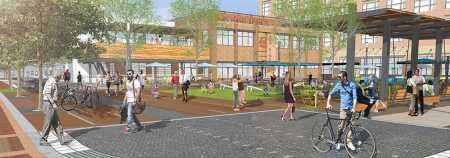
Click to Zoom. Forum attendees also took a walking tour of Midtown Carmel, Ind. Currently under construction, the Monon Boulevard and Midtown Plaza project is changing a section of the trail from simply transportation to a destination, widening and expanding the path into a highly programmed, pedestrian-oriented, multimodal boulevard. (Rundell Ernstberger Associates)
Taking Urbanism to the Suburbs
Twenty miles (32 km) north of Indianapolis, the fast-growing community of Carmel is continuing its own transformation, earning national recognition for quality of life and livability. Through dozens of public/private partnerships in 20 years and the use of tax increment financing (TIF), the community’s longtime mayor, Jim Brainard, has been implementing a vision that prioritizes the built environment and placemaking. Much of the redevelopment has centered around a portion of the Monon Trail that runs through the community.
Justin Moffett, partner with Old Town Design Group, a developer working on multiple Carmel projects, noted that the city of Carmel has had the foresight to invest in infrastructure that results in greater assessed value in the long run, combined with a focus on programming spaces to engage the public. Carmel’s plazas are the site of multiple activities year-round, from a farmer’s market to a Christkindlmarkt.
While mixed-use developments have long benefited from walkability, quality of life, and a sense of place, office tenants are now demanding similar attributes, providing additional daytime traffic and promoting retail viability.
“Walkable developments are setting the highwater mark for lease rates,” said Moffett. The Carmel Monon Trail area is now among Indianapolis-area spots with the highest demand for class A space, a trend Moffett said wasn’t on the radar a few years ago. A one-block area in Carmel will soon house three corporate headquarters.
According to Mike Hollibaugh, director of community services, city of Carmel, there has been a shift “from the US 31 Corridor as our economic and jobs driver to the new building development in downtown with its walkability, mixed use, and higher densities. The jobs are following the city’s investment there.”
Heather Personne, principal with Point B, Phoenix, and a two-time attendee of the Small-Scale Development Forum, noted the “thought-provoking and novel” approach in Carmel. “It’s crucial for placemaking to have active participation from the communities we’re working in,” she said. “With the trail in Carmel, there was a real effort to take advantage of the connection and create a place that didn’t exist. I love that because it’s allowing people to interact with real estate in a new way.”
Making It Work through Partnerships
The work highlighted during the forum underscored the important role of partnerships among the private, public, and philanthropic sectors.
When Mayor Brainard was first elected, he heard community feedback that Carmel lacked a downtown. Recognizing the benefits of density—both from a placemaking and tax revenue perspective—the city bought land, created a master plan, and started talking with developers about public/private partnerships (PPPs). According to Mayor Brainard, ideal PPP partners are “frank with their numbers and pro formas so we can negotiate and have honest discussions to craft P3s that work.”
Moffett said that one of the challenges of public/private partnerships is building something that is both beautiful and buildable, which requires being able to give a little and find common ground that moves the community forward.
“When interested developers come to see us, it’s important they understand what the city’s goals are and have a desire to help the city achieve them,” said Hollibaugh. “The projects we’re doing are helping us achieve our goals for quality of life and hopefully at same time helping developers achieve their goals, and that’s the start of the partnership.” As for the projects, he said they should be able to stand on their own fundamentally, with the city’s participation providing additional resources, primarily TIF.
Bill Taft, senior vice president for the Local Initiatives Support Corporation, a national community development organization that brings together public and private resources to develop equitable communities, discussed the importance of a fourth P—philanthropy. “Ultimately, nothing would happen in low-income neighborhoods without that type of mix,” he said.
Half of LISC’s lending goes to private, smaller developers, and Taft encouraged participants to reach to the LISC branches in their communities for investments, lending, research, and resources.
Taft noted that LISC’s projects would not be feasible without their additional resources, and they are often involved as a second lender.
“We need small-scale developers,” he said. “We’re looking for developers who are creative, stubborn, and who will stick with projects.”
The projects that LISC supports are often complicated but necessary to provide the incremental change, “missing middle” housing, and commercial space that will advance communities, Taft noted.
Throughout the forum, attendees agreed—it’s gratifying to work on small-scale developments that have a meaningful and positive impact on their communities. As forum attendee Jim Gillespie, GRI Partners, New York, said, “The fun thing about these projects is you feel like you’re making a difference.”
As attendee Jeffrey Tyler, development services director with the city of Fairborn, Ohio, said, successful projects often take collaboration between the private and public sectors—the kind of dialogue that the attendees and organizers of the Small-Scale Development Forum hope to foster.
“Public officials benefit from the Small-Scale Development Forum by gaining a greater understanding of the challenges faced when bringing projects to fruition,” Tyler said. “By understanding how and where they can assist, the public official is in a much better position to promote responsible development. The forum is a great place to learn and share ideas from both sides of the issues.”

